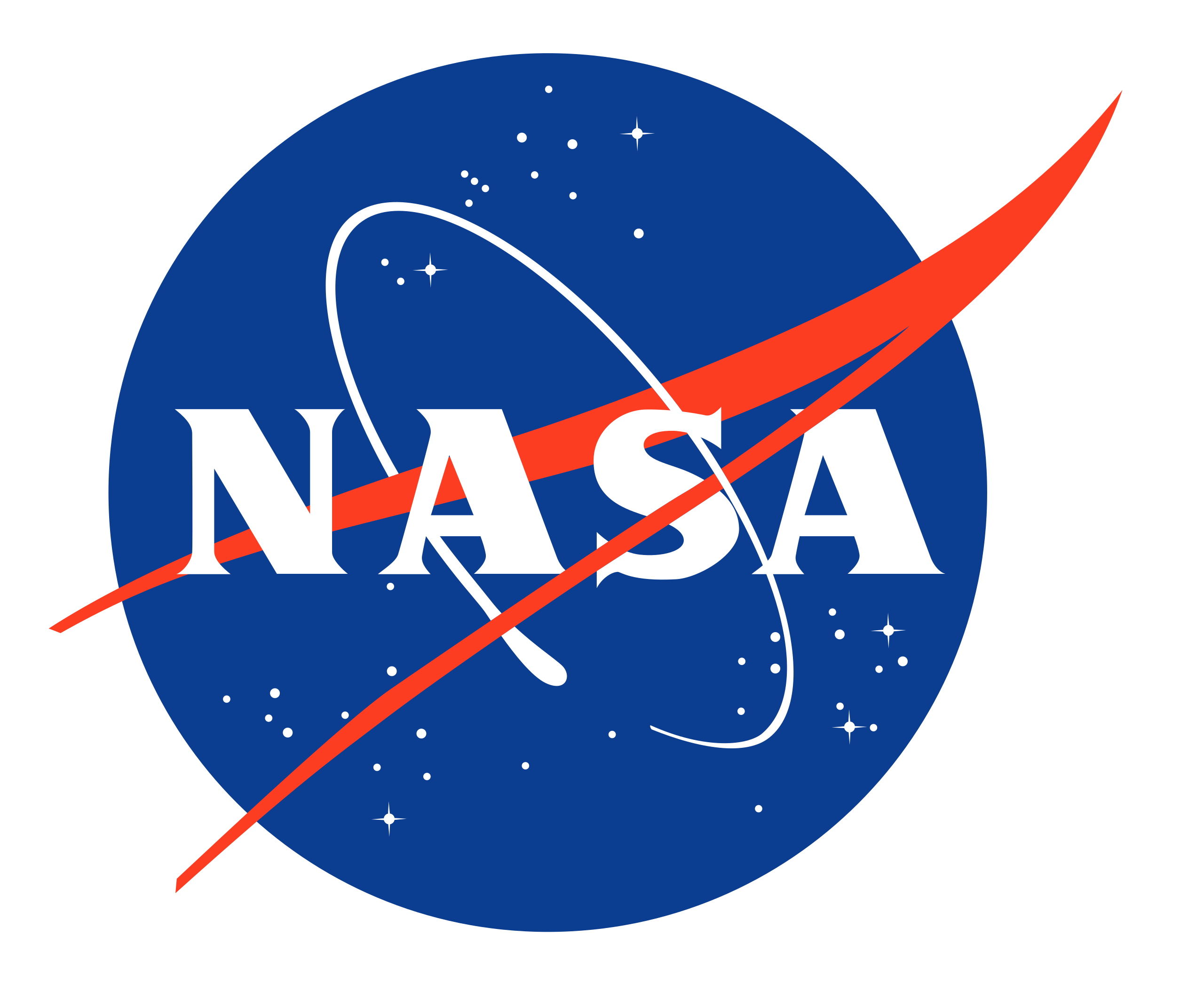Messier 74, also known as the Phantom Galaxy, is seen here in infrared light which showcases its sweeping spiral arms and star-forming regions. This image was created using archival data from NASA's Spitzer Space Telescope, revealing dust clouds that, in visible light, appear dark. Messier 74...
- Image Type
- Subject
- Spectral Band
- Locale
- Image Channels
- Image Coordinates
Whirlpool Galaxy
The Whirlpool Galaxy in Visible and Infrared Light
This image shows the Whirlpool galaxy, also known as Messier 51 and NGC 5194/5195, which is actually a pair of galaxies. Located approximately 23 million light-years away, it resides in the constellation Canes Venatici. This image combines two visible light wavelengths (in blue and green) and...
Whirlpool Galaxy
The Whirlpool Galaxy in Infrared Light
This image shows the Whirlpool galaxy, also known as Messier 51 and NGC 5194/5195, which is actually a pair of galaxies. Located approximately 23 million light-years away, it resides in the constellation Canes Venatici. Here we see three wavelengths of infrared light: 3.6 microns (shown in blue),...
Whirlpool Galaxy
The Whirlpool Galaxy in Visible Light
This image shows the Whirlpool galaxy, also known as Messier 51 and NGC 5194/5195, which is actually a pair of galaxies. Located approximately 23 million light-years away, it resides in the constellation Canes Venatici. This image presents the galaxy's appearance in visible light, from the Kitt...
Spitzer Space Telescope
Spitzer Final Voyage Poster
A poster celebrating Spitzer Final Voyage. On January 30th 2020, NASA's Spitzer Space Telescope will complete its mission. The Spitzer Final Voyage web page will tell its story, showcase new science and highlight its most outstanding achievements during the past 16 years in space.
Cepheus B
Cepheus C and Cepheus B (IRAC)
This image shows data from NASA's Spitzer Space Telescope, from the IRAC instrument, with colors corresponding to wavelengths of 3.6, 4.5, 5.8 and 8.0 m.
Cepheus B
Cepheus C and Cepheus B (IRAC-MIPS)
This image was compiled using data from NASA's Spitzer Space Telescope using the Infrared Array Camera (IRAC) and the Multiband Imaging Photometer (MIPS) during Spitzer's "cold" mission, before the spacecraft's liquid helium coolant ran out in 2009.
Cepheus B
Cepheus C and Cepheus B (IRAC Annotated)
This image shows data from NASA's Spitzer Space Telescope, from the IRAC instrument, with colors corresponding to wavelengths of 3.6, 4.5, 5.8 and 8.0 m.
Cepheus B
Cepheus C and Cepheus B (IRAC-MIPS Annotated)
This image was compiled using data from NASA's Spitzer Space Telescope using the Infrared Array Camera (IRAC) and the Multiband Imaging Photometer (MIPS) during Spitzer's "cold" mission, before the spacecraft's liquid helium coolant ran out in 2009.
First Galaxy Illustration Approximation
This artist's illustration shows what one of the very first galaxies in the universe might have looked like. High levels of violent star formation and star death would have illuminated the gas filling the space between stars, making the galaxy largely opaque and without a clear structure.
A Field of Galaxies Seen by Spitzer and Hubble
This deep-field view of the sky, taken by NASA's Spitzer Space Telescope, is dominated by galaxies - including some very faint, very distant ones - circled in red.
Messier 87
Spitzer Captures Messier 87 (EHT)
This wide-field image of the galaxy M87 was taken by NASA's Spitzer Space Telescope. The top inset shows a close-up of two shockwaves, created by a jet emanating from the galaxy's supermassive black hole. The Event Horizon Telescope recently took a close-up image of the silhouette of that black...
Messier 87
Spitzer Captures Messier 87 (Jets)
The galaxy M87, imaged here by NASA's Spitzer Space Telescope, is home to a supermassive black hole that spews two jets of material out into space at nearly the speed of light. The inset shows a close-up view of the shockwaves created by the two jets.
Messier 87
Spitzer Captures Messier 87
The galaxy M87 looks like a hazy, blue space-puff in this image from NASA's Spitzer Space Telescope. At the galaxy's center is a supermassive black hole that spews two jets of material out into space.
W40
Space Butterfly
What looks like a red butterfly in space is in reality a nursery for hundreds of baby stars, revealed in this infrared image from NASA's Spitzer Space Telescope. Officially named W40, the butterfly is a nebula - a giant cloud of gas and dust in space where new stars may form.
Arp 302
Galaxy Merger Arp 302
This image shows two merging galaxies known as Arp 302, also called VV 340. In these images, different colors correspond to different wavelengths of infrared light. Blue and green are wavelengths both strongly emitted by stars. Red is a wavelength mostly emitted by dust.
NGC 6786
Galaxy Merger VII Zw 96
This image shows the merger of two galaxies, known as NGC 6786 (right) and UGC 11415 (left), also collectively called VII Zw 96. It is composed of images from three Spitzer Infrared Array Camera (IRAC) channels: IRAC channel 1 in blue, IRAC channel 2 in green and IRAC channel 3 in red.
NGC 7752
Galaxy Merger Arp86
This image shows the merger of two galaxies, known as NGC 7752 (larger) and NGC 7753 (smaller), also collectively called Arp86. In these images, different colors correspond to different wavelengths of infrared light. Blue and green are wavelengths both strongly emitted by stars. Red is a...
G54.1+0.3
Supernova Remnant G54
This image of supernova remnant G54.1+0.3 includes radio, infrared and X-ray light.
Cat's Paw Nebula
The Cat's Paw Nebula IRAC
The Cat's Paw Nebula, imaged here by NASA's Spitzer Space Telescope using the IRAC instrument, is a star-forming region inside the Milky Way Galaxy. The dark filament running through the middle of the nebula is a particularly dense region of gas and dust.
Cat's Paw Nebula
The Cat's Paw Nebula MIPS & IRAC
The Cat's Paw Nebula, imaged here by NASA's Spitzer Space Telescope using the MIPS and IRAC instruments, is a star-forming region that lies inside the Milky Way Galaxy. New stars may heat up the surrounding gas, which can expand to form "bubbles."
WASP-121b
Ultrahot Jupiter WASP-121b
These simulated views of the ultrahot Jupiter WASP-121b show what the planet might look like to the human eye from five different vantage points, illuminated to different degrees by its parent star.
HBH3
Spitzer Spies Supernova Remnant HBH3
Thin, red veins of energized gas mark the location of the supernova remnant HBH3 in this image from NASA's Spitzer Space Telescope.
TDE observed in Arp299B
A diagram showing the components of the TDE observed in Arp299B.
Arp 299 Tidal Disruption Event
A Tidal Disruption Event in Arp299B
An image of the galaxy Arp299B, which is undergoing a merging process with Arp299A, captured by NASA's Hubble space telescope. The inset features an artist's illustration of a tidal disruption event, which occurs when a star passes fatally close to a supermassive black hole.
Arp 299 Tidal Disruption Event
Black Hole vs. Star: A Tidal Disruption Event (Artist's Concept)
An artist's concept of a tidal disruption event (TDE) that happens when a star passes fatally close to a supermassive black hole, which reacts by launching a relativistic jet.
TRAPPIST-1
Comparing TRAPPIST-1 to the Solar System
This graph presents known properties of the seven TRAPPIST-1 exoplanets (labeled b thorugh h), showing how they stack up to the inner rocky worlds in our own solar system.
TRAPPIST-1
TRAPPIST-1 Planet Lineup - Feb. 2018
This artist's concept shows what the TRAPPIST-1 planetary system may look like, based on available data about the planets' diameters, masses and distances from the host star, as of February 2018.
TRAPPIST-1
TRAPPIST-1 Planet Lineup - Feb. 2018 (unannotated)
This artist's concept shows what the TRAPPIST-1 planetary system may look like, based on available data about the planets' diameters, masses and distances from the host star, as of February 2018.
TRAPPIST-1
Illustration of TRAPPIST-1 Planets as of Feb. 2018
This illustration shows the seven Earth-size planets of TRAPPIST-1. The image does not show the planets' orbits to scale, but highlights possibilities for how the surfaces of these intriguing worlds might look.
TRAPPIST-1
TRAPPIST-1 Compared to Jovian Moons and Inner Solar System - Feb. 2018
All seven planets discovered in orbit around the red dwarf star TRAPPIST-1 could easily fit inside the orbit of Mercury, the innermost planet of our solar system. In fact, the proportions of the TRAPPIST-1 system look more like Jupiter and its moons.
TRAPPIST-1
TRAPPIST-1 Planet Data - Feb. 2018
This chart shows, on the top row, artist concepts of the seven planets of TRAPPIST-1 with their orbital periods, distances from their star, radii, masses, densities and surface gravity as compared to those of Earth.
Arp 142
Arp 142: The Penguin and the Egg
This image of distant interacting galaxies, known collectively as Arp 142, bears an uncanny resemblance to a penguin guarding an egg. Data from NASA's Spitzer and Hubble space telescopes have been combined to show these dramatic galaxies in light that spans the visible and infrared parts of the...
CoRoT-2b
"Wrong-way" Winds on CoRoT-2b
This illustration depicts the strange case of the backwards hotspot researchers have found on the hot exoplanet known as CoRoT-2b.
WASP-18b Artist's Concept
WASP-18b is an exoplanet located 325 light-years from Earth. The planet's mass is 10 times that of Jupiter, and it orbits its star once every 23 hours.
55 Cancri e with Atmosphere
The super-Earth exoplanet 55 Cancri e, depicted with its star in this artist's concept, likely has an atmosphere thicker than Earth's, with ingredients that could be similar to those of Earth's atmosphere.
Polluted White Dwarf
This artist's concept shows an exoplanet and debris disk orbiting a polluted white dwarf.
Starburst Chart
Over their individual histories, the vast majority of galaxies are thought to produce stars at relatively slow rates. This slow-and-steady pace has continually added to the overall population of stars in galaxies and, by extension, the broader universe, as illustrated along the horizontal/x-axis...
NGC 4993
Flicker of A Neutron Star Merger in Infrared Light
NASAs Spitzer Space Telescope has provisionally detected the faint afterglow of the explosive merger of two neutron stars in the galaxy NGC 4993. The dot framed by the markers may be one of the last detections made in infrared light of this event.
NGC 4993
Spitzer Sees Flicker of Neutron Star Collision
NASAs Spitzer Space Telescope has provisionally detected the faint afterglow of the explosive merger of two neutron stars in the galaxy NGC 4993. The event, labeled GW170817, was initially detected nearly simultaneously in gravitational waves and gamma rays, but subsequent observations by many...
NGC 4993
Infrared View of NGC 4993, Host Galaxy to a Neutron Star Merger
NASAs Spitzer Space Telescope has provisionally detected the faint afterglow of the explosive merger of two neutron stars in the galaxy NGC 4993. This image shows the Spitzer data, but the faint light from the explosion is to faint to be easily seen mixed in the light of the other stars in the...
Giant Exoplanet and Debris Disk
This artist's rendering shows a large exoplanet causing small bodies to collide in a disk of dust.
Tabby's Star
Dusty Ring Around Boyajians Star
This illustration depicts a hypothetical uneven ring of dust orbitingKIC 8462852, also known as Boyajians Star or Tabby's Star.
Brown Dwarf Weather
This artist's concept shows a brown dwarf with bands of clouds, thought to resemble those seen on Neptune and the other outer planets in the solar system.
TRAPPIST-1 System - Artist Concept
This illustration shows what the TRAPPIST-1 system might look like from a vantage point near planet TRAPPIST-1f.
Massive Star Goes Out With a Whimper Instead of a Bang
This pair of visible-light and near-infrared photos from NASA's Hubble Space Telescope shows the giant star N6946-BH1 before and after it vanished out of sight by imploding to form a black hole.
Massive Star Goes Out With a Whimper Instead of a Bang (Artist's Concept)
Every second a star somewhere out in the universe explodes as a supernova. But some extremely massive stars go out with a whimper instead of a bang. When they do, they can collapse under the crushing tug of gravity and vanish out of sight, only to leave behind a black hole.
Warm Neptune HAT-P-26b
The atmosphere of the distant "warm Neptune" HAT-P-26b, illustrated here, is unexpectedly primitive, composed primarily of hydrogen and helium.
Crab Nebula
Crab Nebula from Five Observatories
In the summer of the year 1054 AD, Chinese astronomers saw a new "guest star," that appeared six times brighter than Venus. So bright in fact, it could be seen during the daytime for several months.
Crab Nebula
Crab Nebula from Five Observatories
In the summer of the year 1054 AD, Chinese astronomers saw a new "guest star," that appeared six times brighter than Venus. So bright in fact, it could be seen during the daytime for several months.
Iceball Planet Artist's Concept
This artist's concept shows OGLE-2016-BLG-1195Lb, a planet discovered through a technique called microlensing. The planet was reported in a 2017 study in the Astrophysical Journal Letters.
TRAPPIST-1
TRAPPIST-1 Comparison to Solar System and Jovian Moons
All seven planets discovered in orbit around the red dwarf star TRAPPIST-1 could easily fit inside the orbit of Mercury, the innermost planet of our solar system. In fact, they would have room to spare. TRAPPIST-1 also is only a fraction of the size of our sun; it isnt much larger than Jupiter....
TRAPPIST-1
TRAPPIST-1 Planet Lineup
This artist's conception shows what the TRAPPIST-1 planetary system may look like, based on available data about their diameters, masses and distances from the host star.
TRAPPIST-1
Transit Illustration of TRAPPIST-1
This illustration shows the seven TRAPPIST-1 planets as they might look as viewed from Earth using a fictional, incredibly powerful telescope. The sizes and relative positions are correctly to scale: This is such a tiny planetary system that its sun, TRAPPIST-1, is not much bigger than our planet...
TRAPPIST-1
500 Hours of Spitzer Observations of TRAPPIST-1
This data plot shows infrared observations by NASAs Spitzer Space Telescope of a system of seven planets orbiting TRAPPIST-1, an ultracool dwarf star. Over 21 days, Spitzer measured the drop in light as each planet passed in front of the star. Spitzer was able to identify a total of seven rocky...
TRAPPIST-1
TRAPPIST-1 Statistics Table
This chart shows, on the top row, artist conceptions of the seven planets of TRAPPIST-1 with their orbital periods, distances from their star, radii and masses as compared to those of Earth. The bottom row shows data about Mercury, Venus, Earth and Mars.
TRAPPIST-1f
Surface of TRAPPIST-1f
Imagine standing on the surface of the exoplanet TRAPPIST-1f. This artist's concept is one interpretation of what it could look like.
TRAPPIST-1
The Discovery of TRAPPIST-1 Planets
The first observations of the TRAPPIST-1 system reported in 2016 revealed three planets orbiting a small, red-dwarf star, though the exact location of the outermost one, was not well-determined (yellow band, top image). Follow-up observations with NASA's Spitzer Space Telescope, as well as...
TRAPPIST-1
The TRAPPIST-1 Habitable Zone
The TRAPPIST-1 system contains a total of seven planets, all around the size of Earth.Three of them -- TRAPPIST-1e, f and g -- dwell in their stars so-called habitable zone. The habitable zone, or Goldilocks zone, is a band around every star (shown here in green) where astronomers have calculated...
TRAPPIST-1
Abstract Concept of TRAPPIST-1 System
The TRAPPIST-1 star, an ultra-cool dwarf, has seven Earth-size planets orbiting it. This artist's concept appeared on the cover of the journal Nature in Feb. 2017 announcing new results about the system.
OGLE-2015-BLG-1319
Brown Dwarf Microlensing Illustration
This illustration depicts a newly discovered brown dwarf, an object that weighs in somewhere between our solar system's most massive planet (Jupiter) and the least-massive known star, that was discovered through gravitational microlensing.



